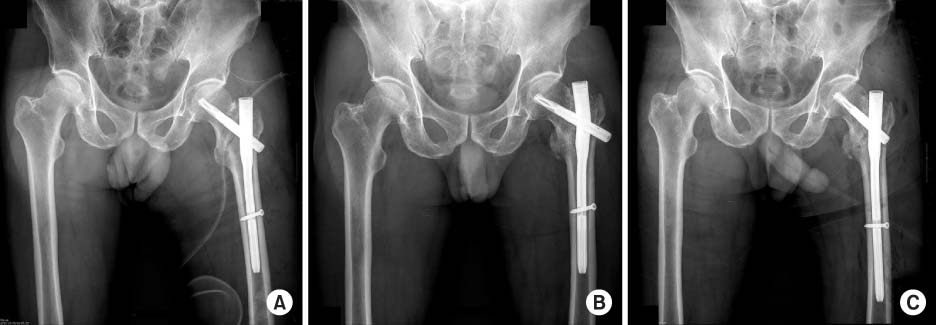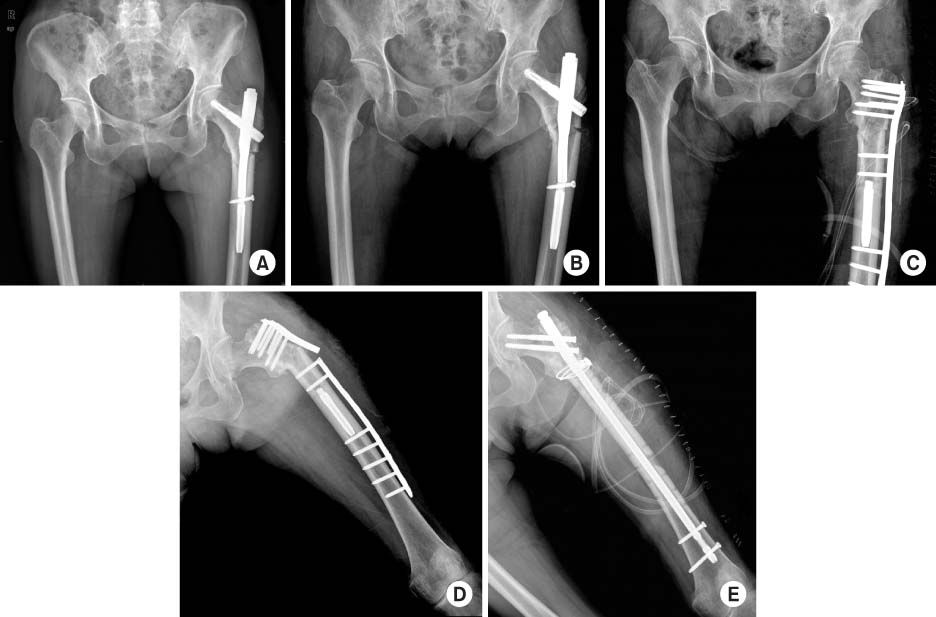Articles
- Page Path
- HOME > J Musculoskelet Trauma > Volume 27(4); 2014 > Article
-
Technical Trick
- Removal Methods for Broken Proximal Femoral Nails Using Ball Tip Guide Wire: Technical Note and Two Cases Report
- Bong-Ju Park, M.D., Hong-Man Cho, M.D.
-
Journal of the Korean Fracture Society 2014;27(4):315-320.
DOI: https://doi.org/10.12671/jkfs.2014.27.4.315
Published online: October 20, 2014
Department of Orthopedic Surgery, Gwangju Veterans Hospital, Gwangju, Korea.
- Address reprint requests to: Hong-Man Cho, M.D. Department of Orthopedic Surgery, Gwangju Veterans Hospital, 99 Cheomdanwolbong-ro, Gwangsan-gu, Gwangju 506-705, Korea. Tel: 82-62-602-6162, Fax: 82-62-602-6164, chm1228@naver.com
• Received: June 13, 2014 • Revised: August 15, 2014 • Accepted: August 27, 2014
Copyright © 2014 The Korean Fracture Society. All rights reserved.
This is an Open Access article distributed under the terms of the Creative Commons Attribution Non-Commercial License (http://creativecommons.org/licenses/by-nc/3.0/) which permits unrestricted non-commercial use, distribution, and reproduction in any medium, provided the original work is properly cited.
- 683 Views
- 2 Download
- 1 Crossref
Abstract
- Recently, the use of intramedullary nailing for proximal femoral fractures has increased. Breakage of the nail usually occurs at the un-united fracture site, and it is a rare complication of intramedullary nailing of the femur. However, removal of the distal fragment of a broken nail is a challenging problem. Herein, the authors describe the methods used for removal of relatively fixed or strongly fixed broken intramedullary nails in two different cases.
- 1. Poehling GG, Webb LX. Retrieval and replacement of a broken Küntscher rod by a closed technique. Technical note. J Bone Joint Surg Am, 1982;64:1389-1390.ArticlePubMed
- 2. Brewster NT, Ashcroft GP, Scotland TR. Extraction of broken intramedullary nails--an improvement in technique. Injury, 1995;26:286. ArticlePubMed
- 3. Kim DS, Kwon CS, Ahn JK, et al. Simple method for the extraction of the broken intramedullary nail of femur: case report. J Korean Orthop Assoc, 1999;34:1171-1174.ArticlePDF
- 4. Park SY, Yang KH, Yoo JH. Removal of a broken intramedullary nail with a narrow hollow. J Orthop Trauma, 2006;20:492-494.ArticlePubMed
- 5. Magu NK, Sharma AK, Singh R. Extraction of the broken intramedullary femoral nail--an innovative technique. Injury, 2004;35:1322-1323.ArticlePubMed
- 6. Georgilas I, Mouzopoulos G, Neila C, Morakis E, Tzurbakis M. Removal of broken distal intramedullary nail with a simple method: a case report. Arch Orthop Trauma Surg, 2009;129:203-205.ArticlePubMedPDF
- 7. Karladani AH. Removal of a broken nail using a guide wire and a screw. Acta Orthop, 2006;77:986-988.ArticlePubMed
- 8. Lee M, Yang KH. Removal of a broken intramedullary nail with a narrow hollow using a bulb-tipped guide wire and kirschner wire: a case report. J Korean Fract Soc, 2010;23:377-381.Article
REFERENCES
Fig. 1Intertrochanteric fracture in a 69-year-old male. (A) The postoperative antero-posterior view of the hip shows a wellreduced trochanteric fracture treated with a proximal femoral nail antirotation. (B) Nonunion and broken nail developed at three months after the first operation. (C) Antero-posterior view of both femurs after exchange nailing.


Fig. 2
(A) Author-made ball tip guide wire (distal tip). (B) Author-made ball tip guide wire (bowing). (C) Removal of the distal segment under fluoroscopic guidance. (D) Eccentric position of the ball tip.


Fig. 3Subtrochanteric fracture in a 69-year-old woman (A) fixed by a proximal femoral nail antirotation (PFNA). (B) Nonunion and broken nail developed at three months after the first operation. (C) The second operation was performed using a locked plate. A broken distal nail tip remained after removal of the proximal part of the PFNA. (D) Nonunion and hardware failure developed at six weeks after the second operation. (E) Antero-posterior view of the left femur after nailing.


Figure & Data
REFERENCES
Citations
Citations to this article as recorded by 

- Breakage of the Tail Portion of the Lag Screw during Removal of Proximal Femoral Zimmer Natural Nail: Report of Two Cases with Technical Notes
Asep Santoso, Ik-Sun Choi, Kyung-Soon Park, Taek-Rim Yoon
Hip & Pelvis.2017; 29(3): 199. CrossRef
Removal Methods for Broken Proximal Femoral Nails Using Ball Tip Guide Wire: Technical Note and Two Cases Report




Fig. 1
Intertrochanteric fracture in a 69-year-old male. (A) The postoperative antero-posterior view of the hip shows a wellreduced trochanteric fracture treated with a proximal femoral nail antirotation. (B) Nonunion and broken nail developed at three months after the first operation. (C) Antero-posterior view of both femurs after exchange nailing.
Fig. 2
(A) Author-made ball tip guide wire (distal tip). (B) Author-made ball tip guide wire (bowing). (C) Removal of the distal segment under fluoroscopic guidance. (D) Eccentric position of the ball tip.
Fig. 3
Subtrochanteric fracture in a 69-year-old woman (A) fixed by a proximal femoral nail antirotation (PFNA). (B) Nonunion and broken nail developed at three months after the first operation. (C) The second operation was performed using a locked plate. A broken distal nail tip remained after removal of the proximal part of the PFNA. (D) Nonunion and hardware failure developed at six weeks after the second operation. (E) Antero-posterior view of the left femur after nailing.
Fig. 4
(A) A small burr was used in the opening. (B) Guide wire retrogradely delivered through the distal end. (C) A large burr was used in the opening. (D) Schanz screw delivered through a widened hole.
Fig. 1
Fig. 2
Fig. 3
Fig. 4
Removal Methods for Broken Proximal Femoral Nails Using Ball Tip Guide Wire: Technical Note and Two Cases Report

 E-submission
E-submission KOTA
KOTA TOTA
TOTA TOTS
TOTS

 Cite
Cite

